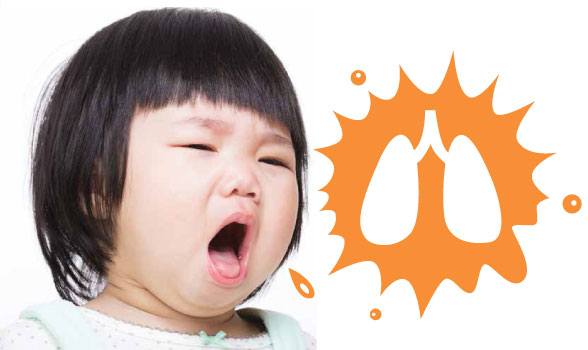Root of the problem
Community Acquired Pneumonia (CAP) can be a serious infection in children and it can be caused by a number of different pathogenic microbes.
- The predominant pathogen in CAP, Streptococcus pneumoniae accounts for about two-thirds of all cases of bacteraemic pneumonia and is the most common cause of CAP in infants between 3 weeks to 3 months of age. It usually follows symptoms similar to the common cold or influenza.
- Bacteria-like organisms, such as Mycoplasma pneumoniae cause “Walking pneumonia” termed for its relatively mild effects which does not require bed rest. It is more common in children older than 5 years-old and adolescents. In countries like the US, it occurs most often in summer or autumn.
- Viruses, specifically respiratory syncytial virus (RSV), is the most common cause of pneumonia in children older than 4 months and younger than 2 yearsold but its effects are usually mild unless the child has a heart disease or underlying illness.
- Fungi – can be found in soil and in bird droppings or even in children’s bedroom. This type of pneumonia is most common in adults and children with underlying health problems (i.e. asthma, diabetes, obesity, heart disease) or weakened immune system (i.e. HIV/AIDS) and in people who have inhaled a large dose of the organisms (i.e. poorly ventilated rooms, crowded households).
Pneumonia in neonates younger than three weeks of age most often is caused by an infection obtained from the mother at birth.
Don’t be alarmed, be informed
The most definitive clinical features of pneumonia in children either community- or hospital-acquired are fever, and one or more of the following – rapid breathing rate, cough, nasal flare, rib muscle retraction, decreased breath sounds, or general breathlessness.
Other common symptoms may include:
- wheezing sounds when breathing
- vomiting, headache
- chest pain, abdominal pain
- decreased activity, fatigue, general physical weakness
- loss of appetite (in older kids) or poor feeding (ininfants), which may lead to dehydration
Your child may be more susceptible to CAP if they:
- Are regularly exposed to prolonged secondary smoke from cigarette smokers, open burning, air pollution or irritants. Note that cigarette smoking is the strongest independent risk factor for invasive pneumococcal disease in immune-competent, non-elderly adults.
- Have chronic underlying diseases such as asthma, congenital heart disease (CHD), recurrent respiratory infections, acute otitis media (middle ear infection), etc. Suffer from a weakened immune system due to HIV/AIDS, chemotherapy and its related medication, prolonged steroid use, as well as organ transplant.
- Suffer from a weakened immune system due to HIV/AIDS, chemotherapy and its related medication, prolonged steroid use, as well as organ transplant.
Breathe a sigh of relief
Infants between 3 weeks and 3 months of age should always be taken to the hospital if there are signs of respiratory distress like rapid breathing rate or breathlessness. They will be given antibiotics and need to be closely monitored. Pre-schoolers on the other hand, who are usually infected by virus-induced CAP, doctors do prescribe antibiotics for them but guidelines allow for withholding treatment if a virus agent is suspected and close follow-up can be ensured.
Normal milder forms of CAP can be treated at home with the help of antibiotics. You can also help your child to ease the pain by:
- Making sure he takes plenty of rest.
- Using a humidifier and breathe in the warm mist.
- Helping him through taking deep relaxing breaths at intervals of every 1-2 hours.
- Drink water, juice, or any liquids in liberal amounts.
- Drink at least 6 to 10 cups a day.
- Ensure clean surroundings – no cigarette smoke, indoor or outdoor pollution, dust, thick carpets, etc.
The ‘super bug’ complex
In most children with CAP, identification of the causative organism is not critical. Therefore the treatment for CAP is usually empirical but knowing the age-specific causes of bacteraemic pneumonia will help guide antibiotic therapy. However, in light of new drug-resistant strains also termed ‘Super Bugs’, a policy for being more restrictive in antibiotic use has been implemented.
The emergence of newly recognised pathogens, such as the novel severe acute respiratory syndrome (SARS) and Middle East respiratory syndrome (MERS) coronavirus has increased the challenge for appropriate management of these infections. Studies have indicated that drug resistant S. pneumoniae is increasing in prevalence worldwide particularly towards penicillin and macrolides (erythromycin, azithromycin and clarithromycin). It is also a concern with patients who have had previous antibiotic therapy, specifically within the past three months before initially contracting pneumonia. It is crucial that these patients receive a drug of a different class (usually oral beta-lactam antibiotics) than before to decrease the risk of pneumococcal resistance. Parents should always be aware of the signs and symptoms of CAP in their children and take measures to address the issue promptly.
An educational contribution by Malaysian Paediatric Association.






Comments